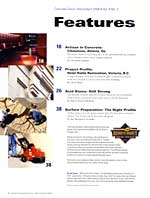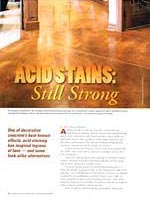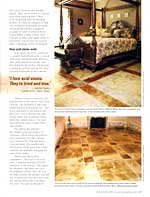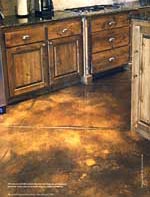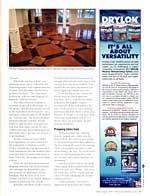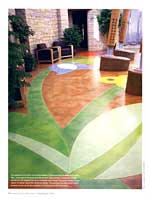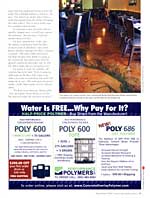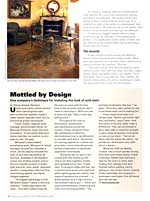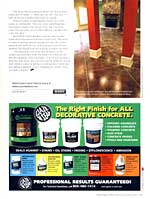Acid Stains:
Still Strong
by Stacey Enesey Klemenc
On the Cover: "Where the Tree is Born," by Tom Ralston Concrete of Santa Cruz, Calif., graces the J. Ellington Library in San Jose, Calif. To create this tree, Ralston and his team laid a thin rubber sheet on top of concrete and cut out a tree branch pattern. He sandblasted the area, then acid-stained the sand-blasted branches.
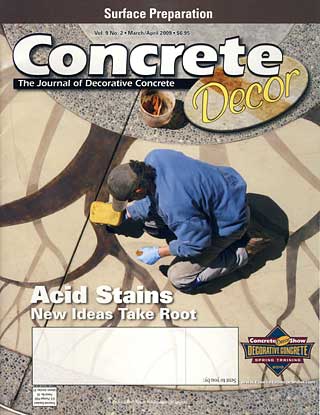
A unpredictable as they are beautiful, acid stains can transform an ordinary slab of concrete into a breathtaking piece of art. Contractors who have learned to successfully use acid stains say no other products on the market measure up to the stains' performance. The special handling, prepping and extensive cleanup acid stains require are worth it.
Acid stains are nothing new. They've has been around since the 1920s, says Scott Thome, director of product services for L.M. Scofield Co.
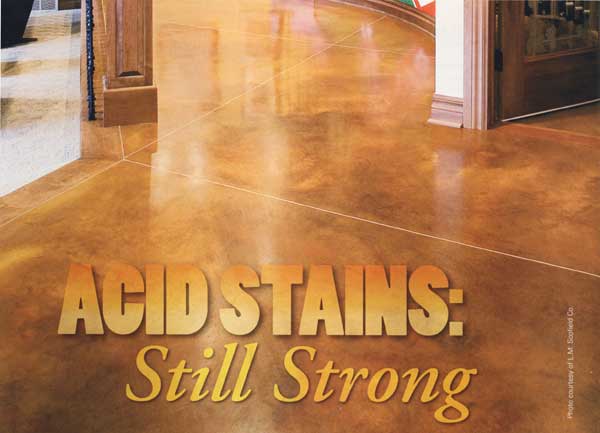
And even with nonacid stains gaining a foothold in today's market, diehards maintain acid stains and their prized visual effects aren't going away anytime soon.
"As more people clamor for Old World-looking pieces, I think the market is going to drive more contractors to offer acid staining," says Tom Ralston of Tom Ralston Concrete, a company founded by his grandfather in 1928 in Santa Cruz, Calif. "It looks antiqued, weather-worn, anything but new." And, many think, it's well worth its troubles because it rivals the variegated stone creations of Mother Nature herself.
|
|
|
|
|
|
|
|
|
|
|
|
Even though its initial makeup is hazardous, acid stains have an environmentally friendly upside. There are no VOCs to contend with while applying them. There is no off-gassing from the finished product, no place for allergens to hide and, if cleaned up properly, no harsh chemicals left behind. Compared to carpet or vinyl, a concrete floor's sustainability is hard to beat. And contrary to what some might think, its hazardous content won't necessarily affect a building's LEED certification.
How acid stains work
Acid stains consist of a mild acid usually hydrochloric acid - mixed with water and metal oxide additives, also called mineral or metallic salts, that penetrate the surface and generate a chemical reaction with the free lime (Calcium hydroxide) in the concrete.
"When it comes to reactivity, the acid has little to do with it," says Chris Sullivan, vice president of sales and marketing for Chemsystems Inc. "The active ingredient is the mineral salt. But if you tried to dissolve the salts in just water, they would just break down into smaller pieces. You need the acid in the water to make these salts soluble."
The mild acidic solution also lightly etches the surface, he continues, which allows the mineral salt to penetrate into the concrete, react with the free lime and form a chemical bond. The metallic salts fill the pores in the paste layer of the concrete, permanently changing the color of the surface.
Thome provides further' explanation. "The acid in the acid stain is (mostly) neutralized by the alkalinity in the concrete. The higher the alkalinity, the better the color development will be. Once the acid becomes neutral, the metallic salts fall out of suspension and then react with the calcium hydroxide to produce the color. The color development is a total chemical reaction and is concrete-dependant.
"Not all concrete slabs have the properties to be stained with every color.. What's more, every color has a different chemical reaction and requires different levels of alkalinity."

The look of this floor was achieved by using a diluted batch of Kemiko Malay Tan stain, along with a bit of Cola stain and diluted black accents. It was finished with a clear sealer.
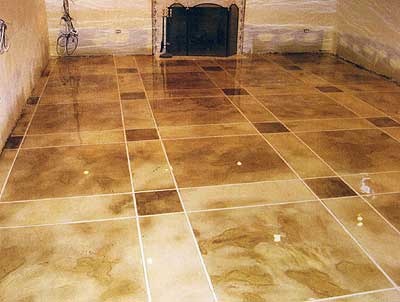
This concrete was covered with SureCrete microtop ping, then stained with a mix of two or three diluted Eco-Stain colors. The floor was then sealed with Dura-Kote 100, a 100 percent epoxy sealer.
It's the varying amounts of calcium hydroxide that cause the mottling and marbling variegation in the translucent acid- stain pattern, Sullivan says. "That's why every job is different - because every piece of concrete is different."
"There are ways to alter the final color, to make it lighter or darker, by changing the initial (amount) of water in the stain:' says Barbara Sargent, representing Kemiko Concrete Products. You also can adjust the amount you spray to achieve different looks and tones, she adds.
Still, in the end, some factors about acid staining remain constant, says Shellie Rigsby, owner of Acanthus Inc. in Plano, Texas. "Acid stains can be manipulated but not controlled. They can be anticipated but not guaranteed."
Safety and other concerns
With acid stain - also called reactive, chemical or penetrating stains - customer expectation is a big hurdle to clear, Rigsby emphasizes. "You can give customers a sample board, but they've got to realize acid stains won' t reproduce exactly as seen."
Temperature and humidity affect color development, says Thorne. If you apply the same color on the same slab at different substrate temperatures, say one at 45 F and the other at 70 F, the resulting colors will differ. "If you have low humidity, the water in the acid stain will evaporate at a faster rate and not allow the full chemical reaction to take place," he explains.
Ralston agrees acid stains are hard to control. "They're messy and can be labor-intensive because you often have to make multiple passes to get the color that's desired," he says. Also, there are really only about 10 basic colors, he says, give or take a few depending on the manufacturer. These can be mixed and matched.
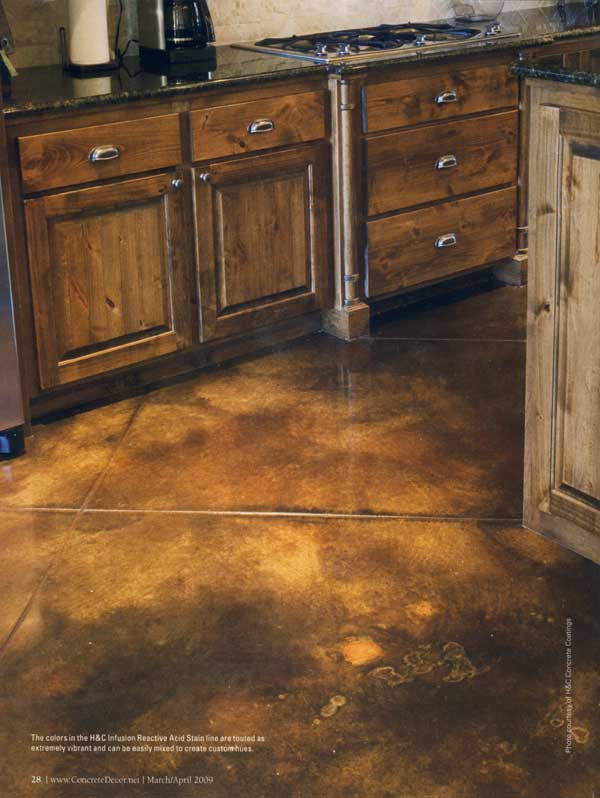
You must wait for the stains to react, Sullivan notes, sometimes up to 12 hours.
When the staining is done, you must take extra care to neutralize any remaining acidity with copious amounts of water. And that water should never go down the drain. "The waste water needs to be collected and disposed of properly," Sullivan stresses.
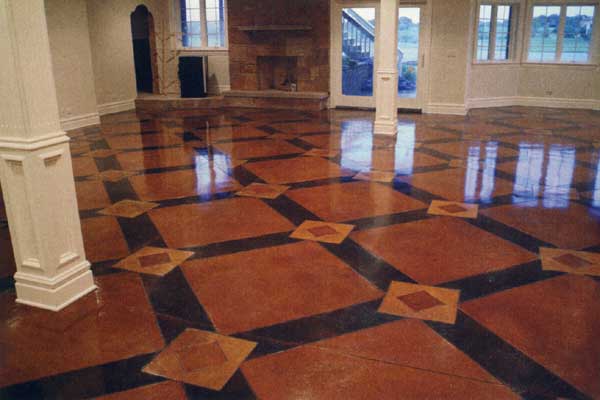
The water-intensive cleanup is necessary to get rid of the residue on the surface that has not reacted, as well as the byproducts of the reaction. "It's a hazardous material until it's all cleaned up," Sullivan says. The brown residual material typically contains chrome, which is right up there with mercury, lead and other heavy metals, he says. "OSHA and other government agencies don't want that to get into our streams or groundwater."
By law, contractors must follow local regulations on how to deal with the waste water. Compliance could involve vacuuming it up and treating it. Some contractors mix the residual water with kitty litter or cement and throw it away. Once dry, the residue is no longer a threat.
There are also hazardous-material shipping concerns, says Keith Boudart, sales manager for Butterfield Color, which means an additional cost for handling. And because of the acid content, you have to use plastic sprayers instead of metal that can corrode.
Rob Ellis, president of SRI Concrete Products, notes that acid stains are no stronger than muriatic acids that anyone can buy from big chain retailers. "You should take the same precautions you would applying a simple acid etch."
To be absolutely safe, contractors should wear an OSHA-approved respirator, gloves, long-sleeved shirts, long pants and goggles, Sargent recommends. If the acid splashes on you, it will eat holes in your clothing and burn your skin. Wash it off at once, she says. If you get it in your eyes, flush with water immediately and go to a doctor. Also, the acid spray can kill unprotected plants.
Prepping takes time
Before you begin any staining project, Sargent says, make sure the floor is clean, the concrete isn't sealed or that something hasn't been added to the mix to keep the stain from reacting. "There are products out there to take off anything," she says. "It's worth every hour you spend prepping for a stain job, because when you're finished, it's permanent."
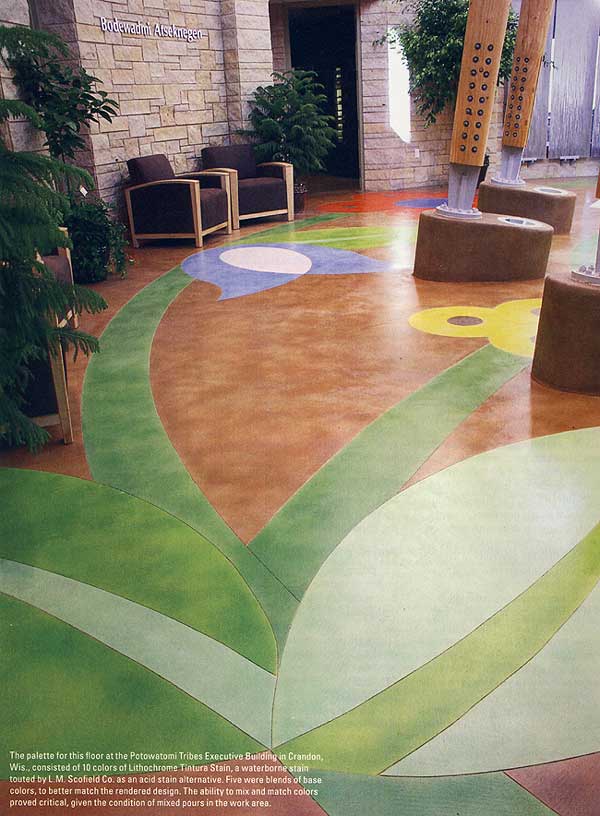
You also need to remove the weak cement paste at the surface before and after you stain, says Thome. Otherwise, the weak layer will be stained and the color will wash off during the residue removal process.
"(After staining,) you need to aggressively break away the cement paste that was weakened by the acid so the sealer has a durable surface to bond to:' he says. "I've seen it too many times when a sealer has peeled from the surface bringing the color with it. This is not a sealer issue. It's a residue removal issue."
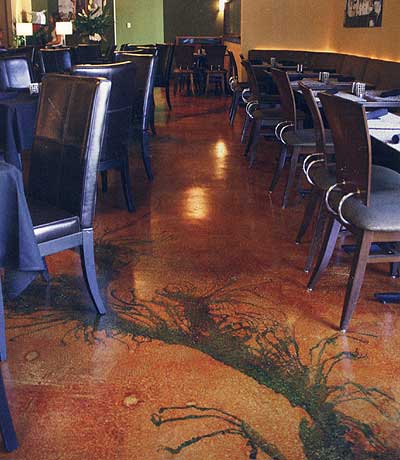
This dragon-tail restaurant floor was created with Butterfield Elements Water- based Stains, including Cordovan Leather for the floor and Verdigris for the dragon tail.
It's imperative that you don't seal too quickly, Sargent says, or you'll just capture the moisture. "Just because it feels dry doesn't mean it is dry."
On new construction, make sure the surface is protected from the likes of electricians or plumbers, says Justin Brazie, product manager for H&C Concrete Coatings. "The other trades disrespect the floor because they think it's going to be covered up. You need to get with the general contractor and make sure he tells the other trades that it's not going to be."
For stains to stick, he explains, the concrete has to be bare. "Even if someone spills pop on the floor and wipes it up, when you come in and spray that spill will jump out at you." The same goes for pencil marks, chalk, burn marks or even silicone spray.
"If a floor is too beat up," Brazie adds, "you can always throw down an overlay. But that will make the job more involved."
According to Sullivan, three key factors need to come together for a successful staining job: porosity, penetration and adhesion. "The surface needs to be porous or there's nowhere for the stain to go. If it's troweled too tight or the surface is contaminated, there is no penetration. The stain just sits on the surface. And if there's no penetration, you won't get any adhesion."
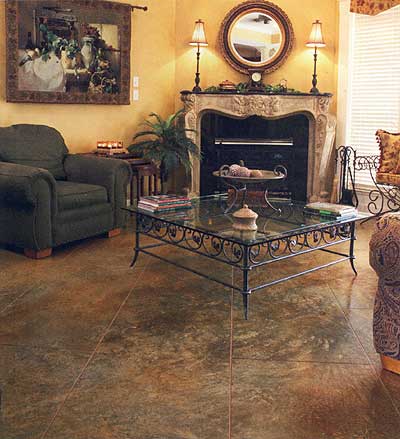
On this floor, diluted Kemiko Malay Tan stain was covered with Kemiko Clear Wax.
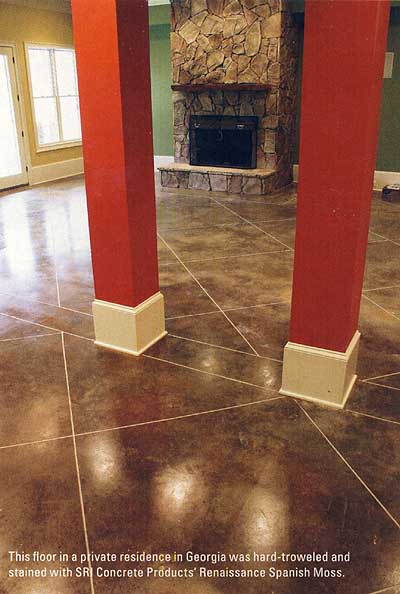
On this floor, diluted Kemiko Malay Tan stain was covered with Kemiko Clear Wax.
A contractor's biggest mistake when it comes to acid staining, he continues, is over applying the product. "Over application causes surface tension, and the stain sits on the surface rather than penetrating it. In this case, less is more."
The rewards
People hooked on acid staining rave about its natural rather than man made-looking results. "Most dyes and pigments cover up what's there, whereas acid stains accentuate the variation," Ellis says.
"The colors you get from reactive stains are stone tones or earthy colors, like rust, deep chocolate, copper patina, amber and golden colors," says Rigsby. "I love acid stains. They're tried and true. They embrace the natural characteristics of concrete, resulting in a stone-like appearance that in and of itself is artistic."
The Texas-based contractor points out that reactive stains are UV-stable - "Most dyes are not," she says and can be successfully used inside or outside.
When it comes to individuality, Brazie says, acid stains are unbeatable. "You can create something that's very hard to repeat. You can get close, but it wont be exact, because there are so many different variables that come into play."
Butterfield Color's Boudart concedes that reactive stains aren't the easiest material to work with. "But when it comes to getting natural variegated looks, they pretty much do the work for you. Acid stain gives you the best mottled, Old World look out of all the products out there."
"I'm amazed at a lot of the new products on the market and how they work, but there's no substitute for the old standards," Ellis concludes. "A lot of new products look like acid stains, but you won't get the longevity of acid stain when it comes to fading or washing away. You're not just adding a pigment, you're changing the surface. They just don't compare."
Want to learn more? Search online at Concrete Décore.

